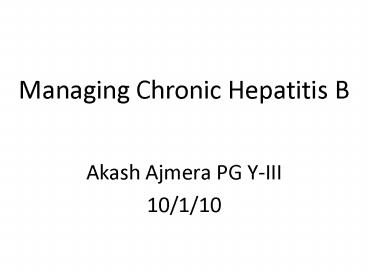Managing Chronic Hepatitis B - PowerPoint PPT Presentation
1 / 19
Title:
Managing Chronic Hepatitis B
Description:
Managing Chronic Hepatitis B Akash Ajmera PG Y-III 10/1/10 Hepatitis B Double-stranded DNA virus Family of hepadnaviruses Eight genotypes (A to H) geographical ... – PowerPoint PPT presentation
Number of Views:74
Avg rating:3.0/5.0
Title: Managing Chronic Hepatitis B
1
Managing Chronic Hepatitis B
- Akash Ajmera PG Y-III
- 10/1/10
2
Hepatitis B
- Double-stranded DNA virus
- Family of hepadnaviruses
- Eight genotypes (A to H) geographical variance
- 300 million HBV carriers in the world
- 500,000 die annually from related liver disease
- Related hospitalizations, cancers, and deaths in
the US have more than doubled in past decade
3
Outcome
- Progression to chronic hepatitis determined by
the age at infection - 90 for a perinatally acquired infection
- 20 to 50 for infections 1-5 years
- lt5 for an adult-acquired infection
- Complete eradication rare after recovery
- HBV DNA nt in blood, liver with evidence of
liver damage
4
(No Transcript)
5
HbeAg positive patients
- Treat those with ALT gt2 x ULN
- Recurrent hepatitis flares, icteric flares,
advanced histologic findings (moderate/severe
inflammation or bridging fibrosis/cirrhosis),
gt40y with persistently high HBV DNA levels. - Delay for 3-6 mth in newly diagnosed HBeAg ve
with compensated liver disease spontaneous HBeAg
seroconversion
6
HbeAg negative patients
- Treat immediately if HBeAg -ve chronic hepatitis
(ALT gt2 x ULN and HBV DNA gt2000 IU/mL) as
sustained remission is rare in the absence of
treatment - Fluctuating course serial f/u to differentiate
an inactive carrier state from HBeAg ve chronic
hepatitis
7
Interferon
- Standard interferon thrice weekly
- Pegylated interferon once a week
- Finite duration of Rx
- No resistant mutants, more durable response
- Young patients with well compensated liver
disease - Genotype A
8
Lamivudine
- Lower cost
- Safety profile, many years of experience
- Safer in Pregnancy
- Higher resistance
- Lower remission rates compared to newer drugs
- Diminishing role with newer Rx
9
Adefovir
- For lamivudine resistant HBV
- Virus suppression is slow and low
- Upto 30 resistance with 5 yr treatment
- Nephrotoxic
- Diminishing role with newer Rx
10
Entecavir
- Potent antiviral activity
- Low rate of drug resistance
- May have role in decompensated cirrhosis
- Upto 50 resistance in lamivudine-resistant
patients
11
Tenofovir
- Can be used as first line treatment in
treatment-naïve patients - Also in patients with lamivudine or
entecavir resistance - Will probably replace adefovir in countries where
it is approved because of its more potent
antiviral activity - Resistance rare after upto two years Rx
12
Duration of Rx
- Standard interferon
- HbeAg ve 4-8 months
- HbeAg ve 12-24 months
- Pegylated interferon 12 months
13
Duration of Rx (NI)
- HbeAg ve Endpoint is loss of HbeAg. Continue 6
mo after seroconversion - HbeAg ve Endpoint not established. Rx can stop
in pts with loss of HbsAg - Most patients require 4-5 yrs of Rx
- Lifelong Rx recommended in cirrhosis
14
Special situations
- Entecavir better in renal failure or patients at
risk for renal failure - Interferon contraindicated in decompensated
cirrhosis - Any oral agent for interferon failed therapy,
response similar to Rx naive patients - In HIV co-infected patients, can use Truvada
(emtricitabine tenofovir)
15
Resistance prevention
- Avoid unnecessary treatment
- Initiate treatment with potent antiviral with low
rate of drug resistance or combination therapy - Switch to alternative therapy in patients with
primary non-response
16
Resistance monitoring
- Test for serum HBV DNA (PCR assay) every 3-6
months during treatment - Check for medication compliance in patients with
virologic breakthrough - Confirm antiviral resistance with genotypic
testing
17
Resistance
- Lamivudine-resistance ? Add adefovir or tenofovir
- Adefovir-resistance ? Add lamivudine Switch to
or add entecavir - Entecavir-resistance ? Switch to tenofovir
18
Surveillance for HCC
- HCC can develop in normal liver
- RCT on 20,000 Chinese patients showed decreased
mortality with surveillance over 20 year period - Due to early detection Rx of HCC
- 6-12 monthly US /- AFP is recommended for
surveillance in chronic hepatitis B
19
- Nodules lt1 cm usually NOT HCC monitored every
three months - Nodules gt1 cm evaluated by CT scan and/or MRI
with contrast - If both show the typical radiological features of
HCC (hypervascularity with washout in
venous/portal phase) or AFP gt 200 ng/ml, the
diagnosis is confirmed biopsy not necessary - If one or neither show the typical features of
HCC, a biopsy is required































![Global Hepatitis B Virus [HBV] Treatment Market: Opportunities and Forecast (2017-2022) PowerPoint PPT Presentation](https://s3.amazonaws.com/images.powershow.com/9006085.th0.jpg?_=201802220712)